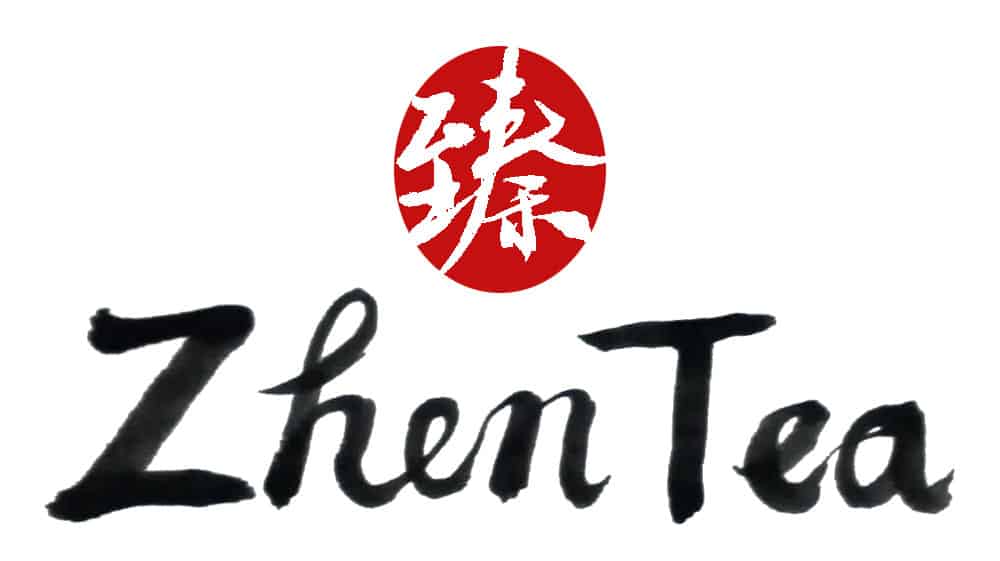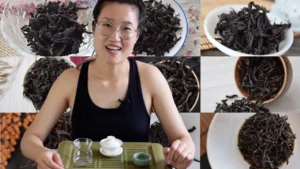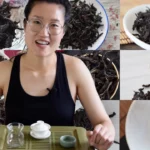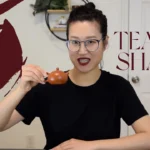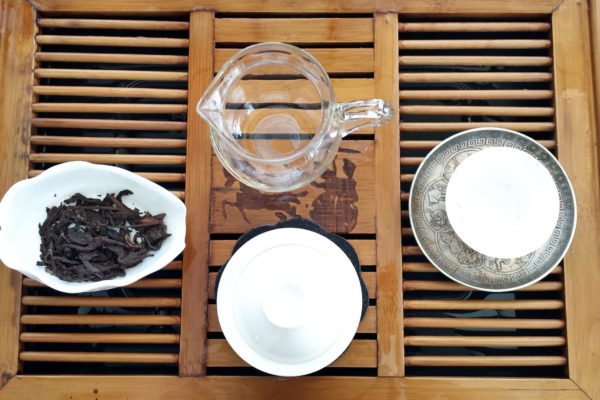
Having just returned from Coffee and Tea Festival NYC, we celebrated our debut in America with an extremely rare Pu’er tea – Bai Nian Song Pin. Before rushing to show the pictures and tasting notes, let me introduce Song Pin properly. To do that I’ll cover the tea producer’s history and ultimate demise, which resulted in much counterfeiting and mimicry and finally I’ll get to the much anticipated tasting notes and pictures. To give you an idea of the rarity of this tea, another Song Pin Ji Pin tea of this grade and vintage was recently auctioned for approximately ¥3’000’000 (approximately $484’000USD).
The Origin – Song Pin Hao
Established in AD1875, Song Pin Hao is famous for producing high quality pu’er tea. Qian Li Zhen Hao (乾利贞号 originally as 钱利贞号) was another major brand that provided herbs, cotton, deer antlers, and tea. A strategic marriage united the the two brands under one label, Qian Li Zhen Song Pin Hao, and they expanded the business and began to focus exclusively on pu’er tea. They produced mountains of pu’er tea, and like most Chinese tea producers they produced the full spectrum of grades from regular to top grade. Some of their regular grades of pu’er were Yiwu Yuan Bao Cha, Feng Mei Gong Cha, Qian Li Cha, Tong Li Cha. But none of them were under the name of their flagship tea, Qian Li Zhen Song Pin Hao.
The combined company experienced decades of prosperity and renowned pu’er tea production, distributing a wide variety of pu’er brands, Yiwu Yuan Bao Cha, Feng Mei Gong Cha, Qian Li Cha and Tong Li Cha to name just a few. They even opened a branch in Hong Kong in 1900’s under the brand name Fu Hua Hao Song Pin Mai. But none of their other labels were as renowned as Song Pin Hao. After decades of success, other factors beyond the control of the tea producer started to weigh on the company and in fact, the whole industry. During the 1930’s many tea production facilities were forced to close their doors. War and economic ‘reforms’ were taking their toll, and sadly, Song Pin Hao were forced out of business. This was the last authentic Qian Li Zhen Song Pin Hao ever produced.
Nowadays, due to its unparalleled quality, Qian Li Zhen Song Pin Hao has picked up a couple ‘nicknames’, which reflect its revered status. Bai Nian, a term that means ‘hundred years’ and Ji Pin meaning ‘pinnacle grade’ are now used in the names of this tea. Bai Nian Song Pin (百年宋聘) or Song Pin Ji Pin (宋聘极品) are both commonly used modern titles for this great tea. These esteemed titles are reserved for the highest grades of historic tea produced by Qian Li Zhen Song Pin Hao, before the 1930’s. Obviously this rare pu’er tea is extremely scarce, but somehow, it relatively easy to find on the market today. How can this be?
The Chaos
Well, almost all of them are fake. Unfortunately, as with all things of great value, the fame and wealth that could be generated by this tea also brought on legions of imposters and fakers. Some of them use the counterfeit neifeis (the sheet pressed into the pu’er cake).
Some of them are only pseudo fake, having originated from the pre 1930’s Song Pin Hao producer, but they are misrepresented as Qian Li Zhen Song Pin Hao when they are actually a regular grade tea from the same producer. Not surprisingly, real Qian Li Zhen Song Pin Hao is exceedingly rare.
To make matters even more confusing, the Hong Kong Branch survived the devastating economy of the 1930’s and 40’s and continued distributing pu’er tea. But in the late 70s, the Hong Kong branch decided to capitalize on their brand heritage and started distributing pu’er tea under the Song Pin brand again. Other less honourable manufacturers began using Vietnamese and Guangdong pu’er leaves to press into bings with a fake Song Pin Hao neifei. Others use tea leaves from Chiang Mai, Thailand to make counterfeit Song Pin pu’er. In the 1990’s and 2000’s, tea factories even revived the Song Pin Hao brand by re-registering the name and made valiant efforts to recover Song Pin Hao’s famed tea making techniques. Regardless of their success or failure in producing tea similar to the original Song Pin Hao, they simply cannot be real Song Pin Hao.
It is a once in a lifetime opportunity to come across a real, original, top grade Song Pin Hao. They are made with the pinnacle quality pu’er leaves from Yiwu zheng shan. To be able to taste this amazing rare pu’er was an honor and a privilege that I am grateful to be able to share with you.
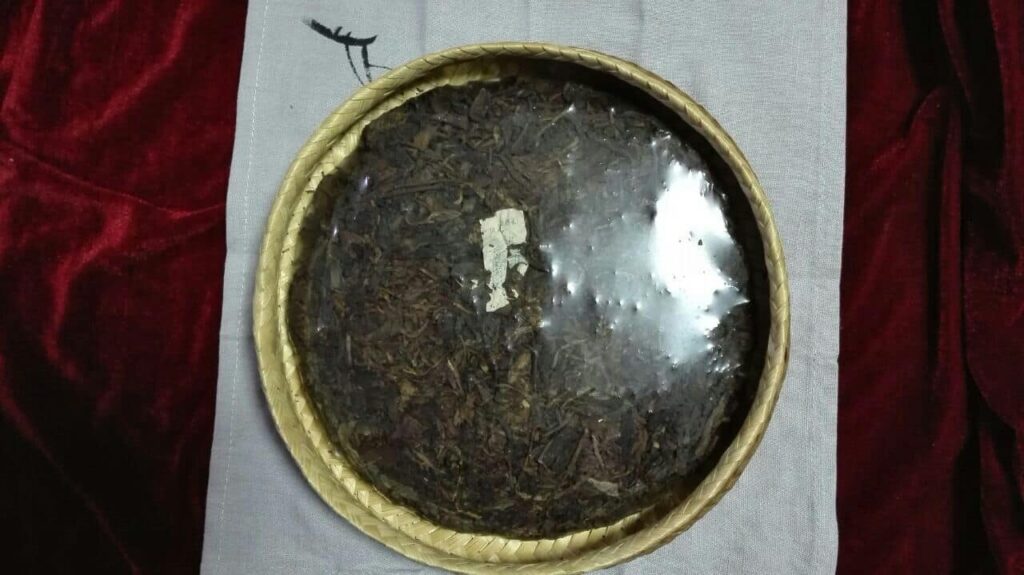
Song Pin Hao Full Bing
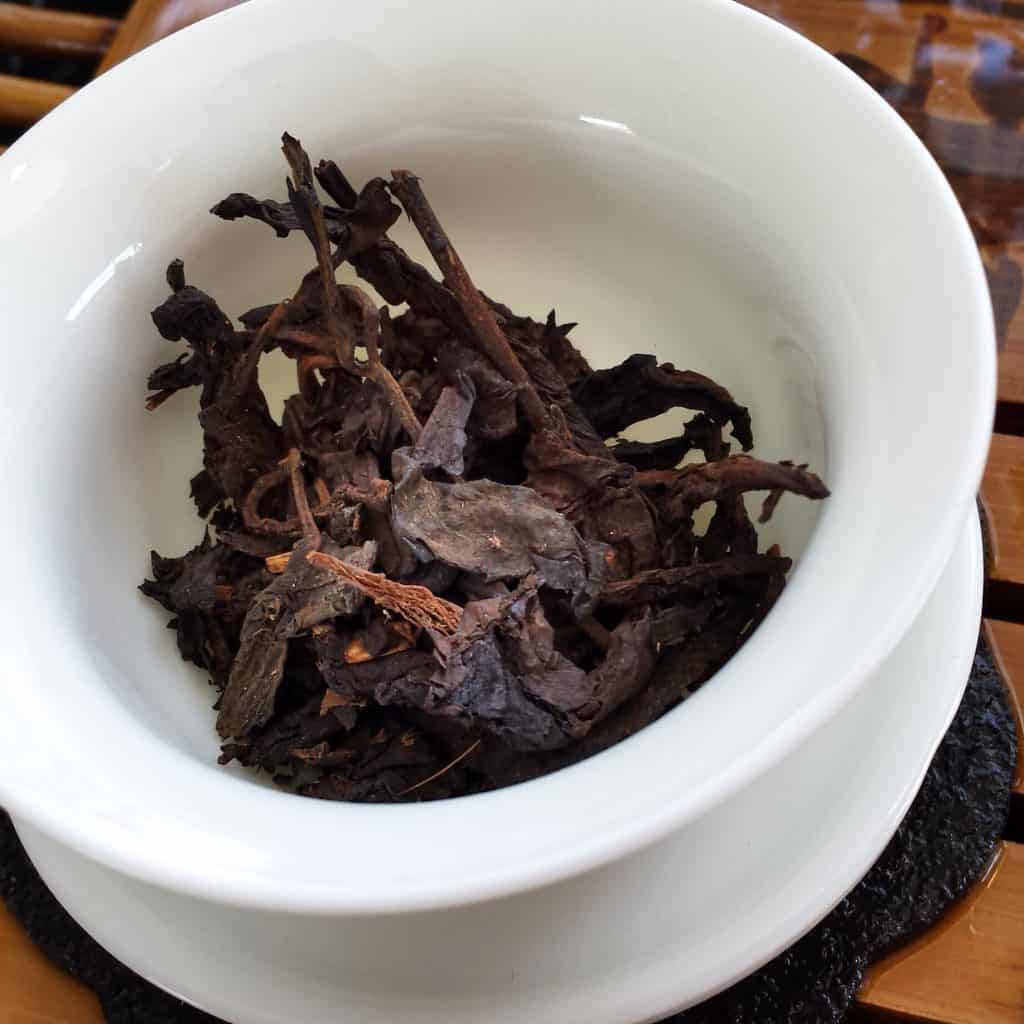
Song Pin Hao Dry Leaves
As I wrote about in an earlier blog post, Shu pu’er can be simply understood as the process that was invented to accelerate the “aging” of sheng pu’er. Observe the colour of the dry leaves of this aged sheng pu’er, so similar to the colour of shu pu’er, a deep, exotic red.
Take a closer look at the leaves and you will notice tiny white dots on the tea. With a magnifying glass, it’s possible to see that they are actually light yellow. These little dots are called jinhua (gold flower), which is actually a bacteria called eurotium cristatum, known for its amazing health benefits. Jinhua is highly desirable in Pu’er and other dark tea because aside from its prominent health benefits, it also has positive influence on the flavour and the texture of the tea liquor.

Song Pin Hao Neifei
The Neifei (内飞) is the piece of paper that is pressed into the tea at the time is formed into a bing. It is used to illustrate the brand and give a brief introduction of the tea. Because it is integrated with the tea, it also becomes an anti-counterfeit feature. In old times, the neifei was actually made of sticky rice (glutinous rice).
This is the neifei from finished bing of Song Pin Hao that we had which was the same as this antique pu’er. The characters of 春尖 (chunjian) illustrate the grade of the tea. Chun means spring and jian means the top. Song Pin Hao used this term to indicate their top quality tea.
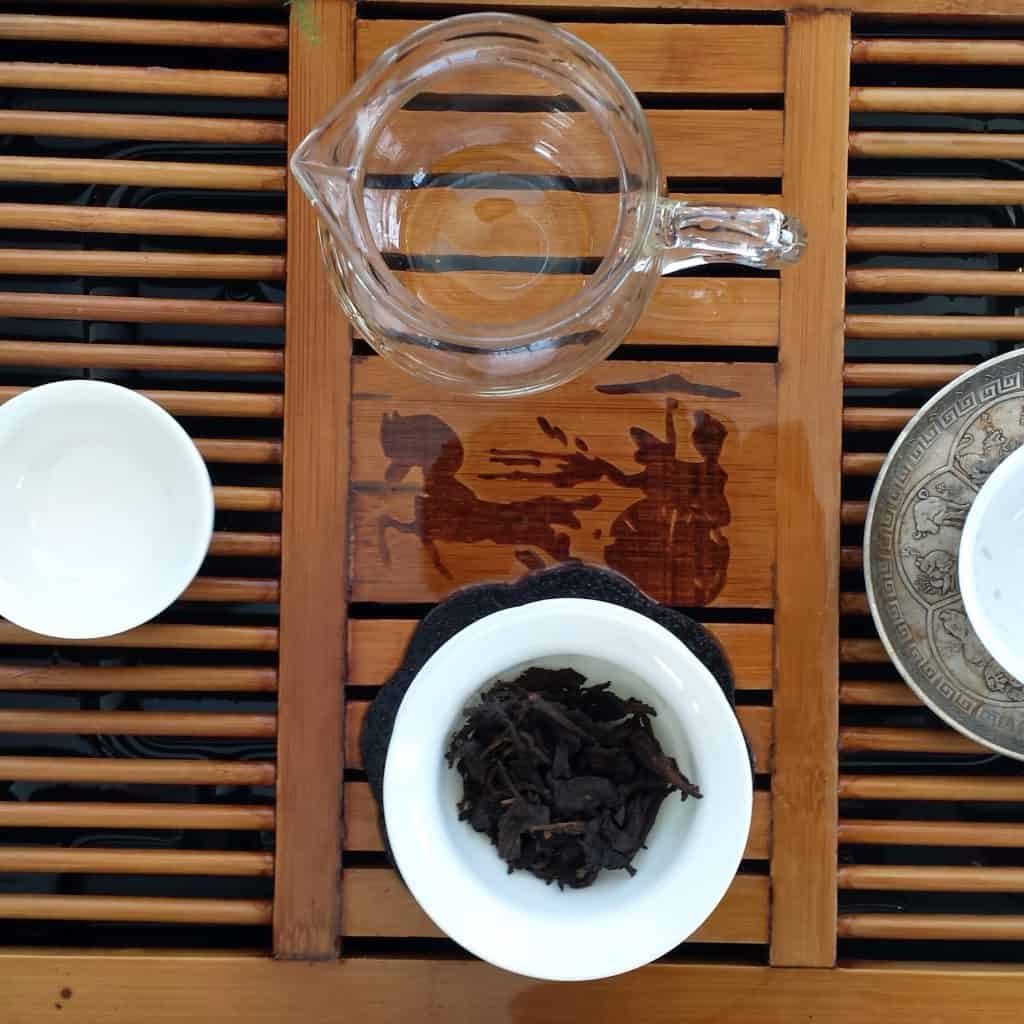
before brewing
The leaves that we have were not broken from the bing, they are the ones that naturally fell off the bing during aging. As such, we only ended up with three grams in our gaiwan (2.8 grams to be precise), so we used a tiny little gaiwan to brew it, and the whole experience was beyond words.
The aroma of this rare pu’er tea was very light when handling the dry leaf but once placed in a prewarmed gaiwan the signature scent of camphor tree, which is a smell of time and age, began to fill the air.
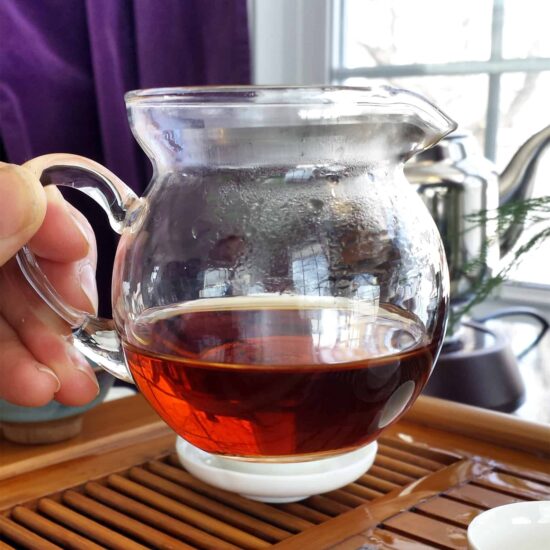
Liquor of the First Infusion
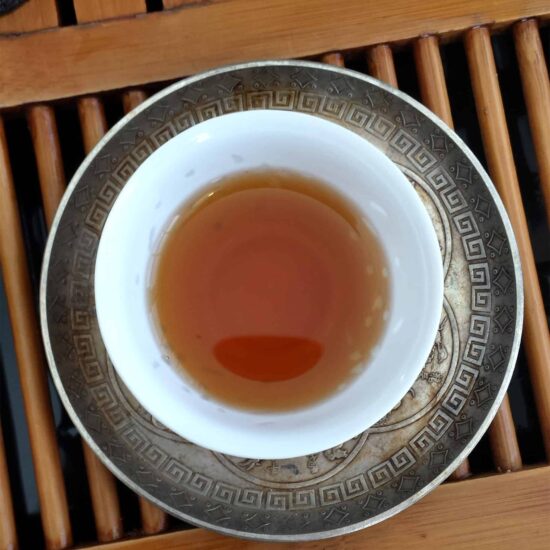
Liquor in Cup

The 15th Infusion

15th Infusion
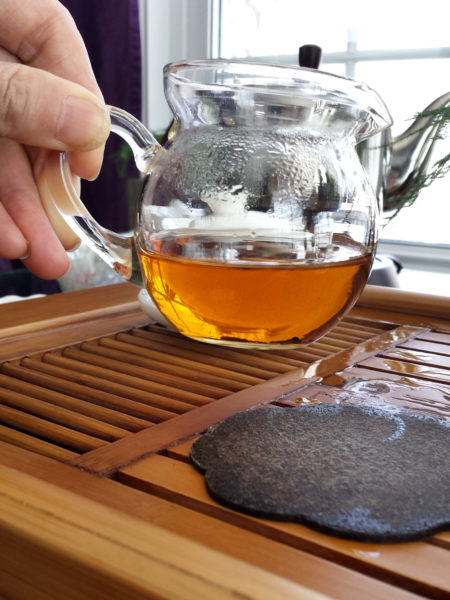
Liquor of the 15th Infusion
Upon first taste, the distinctive flavour of camphor tree rouses me. It is strong but not overwhelming. The flavour itself is indicative of the plantation – it’s most definitely from a tree, not a shrub or bush. It is a natural woody flavour, not induced from smoking or roasting. Year after year of aging has brought out the true character of the tea. Under the flavour of camphor tree was the rich, round and complicated liquor taste. I describe it as light porridge soup. It is a rather Chinese description. Let me try and explain what porridge soup means to me and see if you can imagine it. Porridge soup is simply rice and water in a 15:1 ratio, boiled for 30~60 minutes. The water turns into thick, even slightly sticky white soup with a light fragrance of rice. It is a soothing soup that I have enjoyed since childhood. To get over a cold, to warm up on a cold day, it is a comfort food for me. A taste of home. That is what this aged pu’er reminded me of. The liquor created a kind of textural illusion on the palette that embodied that delicious thickness in the mouth, creating a texture and aroma were tremendously soothing, even welcoming. You would think that the camphor tree flavour combined with a light porridge soup aroma would be conflicted, but they were actually well balanced in this cup of tea and made for a surprisingly delightful combination!
The liquor started as maroon, the color of a burgundy wine. Against the sunlight, the clarity of the liquor was apparent and glowed with a soft radiance. As we progressed through the infusions, the liquor very gradually lightened its color to amber and then orange. Per contra, the taste remained remarkably consistent although in later infusions, the smooth thickness of the liquor texture disappeared, and the light flavor of chenpi emerged.
We finished this delectible rare pu’er tea at the 26th infusion. Three grams of this stunning pu’er rendered 26 infusions of consistent flavour and aroma! Even when we finished it, the aroma was still delighting us!
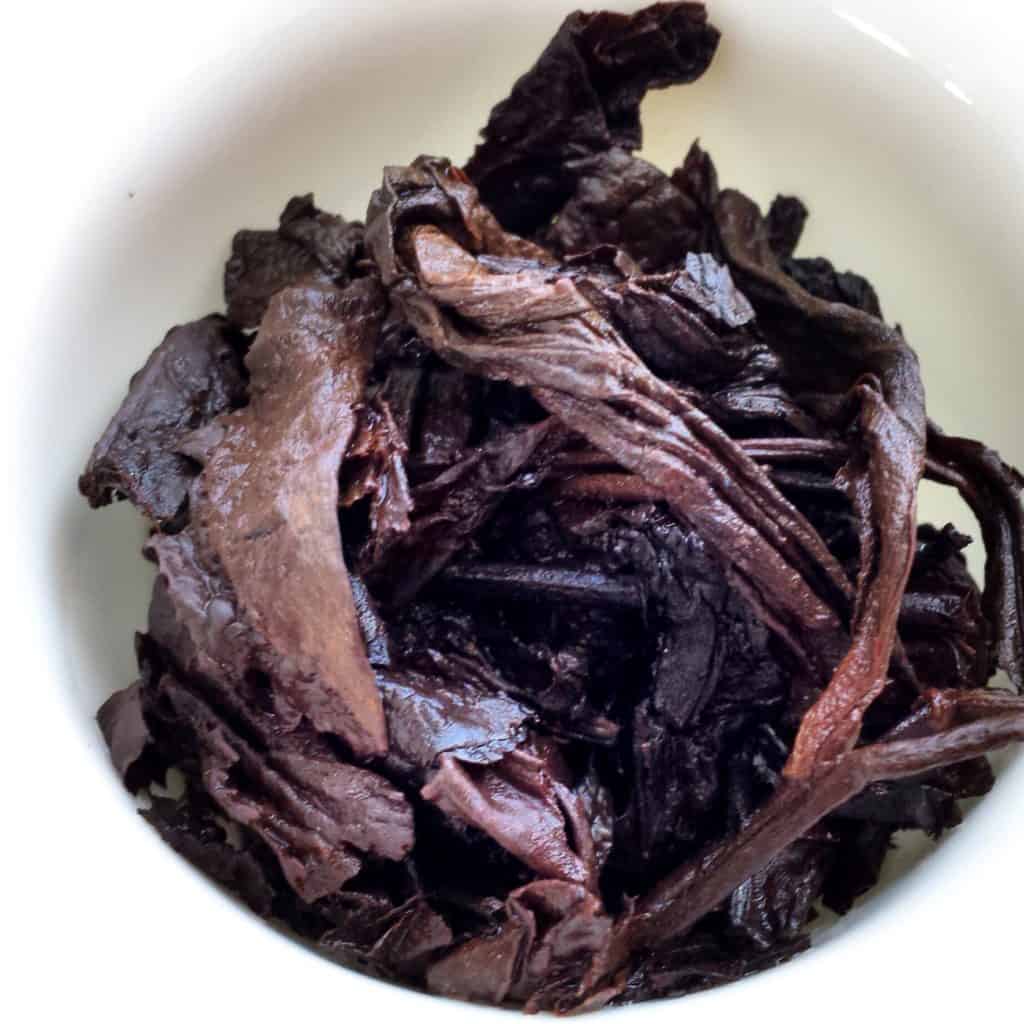
Brewed Leaves

Individual Leaves
Cha Qi 茶气
Cha dao is really a journey. To help describe the art of tasting tea, I’m going to describe the process in layers. The first is recognising the difference between the tea categories, followed by differentiating teas of the same category. Then we move to tasting the tea’s aromas and flavours and gradually we develop the ability to feel the tea, to see the unseen, and get in touch with the nuance. Finally, especially with great teas, we come to understand cha qi, the qi of the tea. After a few cups some teas deliver exceptional warmth in lower part of the abdomen, not to be mistaken with the physical warmth you feel in your tummy from the heat of the tea. You may also feel this warmth in your lower back or waist. This antique pu’er offered a totally unique cha qi experience for me and Jianli Wu, our tea consultant. We both felt a warmth gathering around our ‘Dazhui Xue’ (the back of our lower part of the neck). However, Phil didn’t experience this. The feeling of cha qi is very personal and depends on a person’s sensitivity among other factors. I think the reason why I felt it and he didn’t is related to my regular practice of meditation and qigong.
The Age of this Rare Pu’er Tea
Honestly, it is impossible for us to know the age of this Song Pin Hao. It is well known that among antique pu’er the exact year is almost never known. The concept of aging pu’er started in the 1990’s. Before that, tea producers were very focused on selling all of their tea every year. And if you are trying to sell all of your tea, why bother to label the year? Luckily, it wasn’t always possible for producers and vendors to sell all of their tea, and their misfortune became our precious rare pu’er tea. All we can say our Song Pin Hao is that it was made before the 1930’s. We know this because Song Pin Hao was forced to close around that time. A friendly tip for those who are interested in collecting antique pu’er – an antique pu’er that claims to have an exact production year is suspicious. Nowadays, pu’er is similar to wine and everybody labels their pu’er carefully, but in old times they definitely did not.
This was indeed an once a lifetime experience. Even though I was raised drinking all kinds of supreme aged pu’er, this magnificent tea still blew my mind. I am sharing this fortuitous experience in this blog post and dedicating it to all those who love pu’er.
